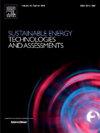重新确立和阐明热电联产系统的正确运行战略基础
IF 7.1
2区 工程技术
Q1 ENERGY & FUELS
Sustainable Energy Technologies and Assessments
Pub Date : 2024-11-22
DOI:10.1016/j.seta.2024.104091
引用次数: 0
摘要
跟踪热负荷(FTL)和跟踪电负荷(FEL)的运行策略对于热电联产系统(CHPs)的各种研究和应用至关重要。然而,本研究揭示了长期以来对 FEL/FTL 策略的错误应用,导致几十年来全球能源效率严重低下。通过严谨的数学推导和反例分析,本研究强调了传统 FEL/FTL 方法的不足之处,并主张对其进行修正,以提高节能效果。随后,利用修正后的运行基础,本研究介绍了推导适用于各种热电联产的最佳策略图的综合方法。考虑因素包括原动机类型、电网效率和热能浪费最小化。一项案例研究表明,与传统能源供应方案相比,我们提出的方法可使燃料消耗减少 12%。重新定义的热电联产运行基础不仅纠正了现有做法,还为该领域的未来研究提供了正确的参考。本文章由计算机程序翻译,如有差异,请以英文原文为准。
Re-establishing and Elucidating the right operation strategy foundation for combined heat and power systems
The operational strategies of Following Thermal Load (FTL) and Following Electricity Load (FEL) are pivotal for combined heat and power systems (CHPs) across diverse research and application contexts. However, this study reveals a long-standing misapplication of the FEL/FTL strategy, leading to substantial global energy inefficiencies persisting for decades. Through rigorous mathematical deduction and counter-example analysis, this research highlights the inadequacies of the conventional FEL/FTL approach and advocates for its revision to enhance energy conservation. Subsequently, employing the corrected operational foundation, this study introduces comprehensive methodologies for deriving optimal strategy maps applicable to various CHPs. Considerations include prime mover type, power grid efficiency, and the minimization of wasted thermal energy. A case study demonstrates that our proposed methodology can result in a 12 % reduction in fuel consumption compared to conventional energy supply schemes. The redefined operational foundation for CHPs not only rectifies existing practices but also provides a correct reference for future research in this domain.
求助全文
通过发布文献求助,成功后即可免费获取论文全文。
去求助
来源期刊

Sustainable Energy Technologies and Assessments
Energy-Renewable Energy, Sustainability and the Environment
CiteScore
12.70
自引率
12.50%
发文量
1091
期刊介绍:
Encouraging a transition to a sustainable energy future is imperative for our world. Technologies that enable this shift in various sectors like transportation, heating, and power systems are of utmost importance. Sustainable Energy Technologies and Assessments welcomes papers focusing on a range of aspects and levels of technological advancements in energy generation and utilization. The aim is to reduce the negative environmental impact associated with energy production and consumption, spanning from laboratory experiments to real-world applications in the commercial sector.
 求助内容:
求助内容: 应助结果提醒方式:
应助结果提醒方式:


